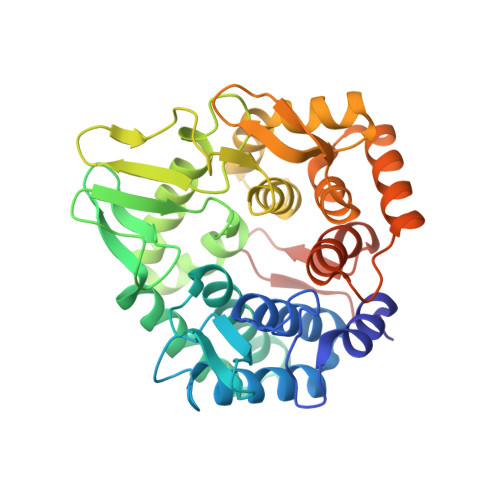Apo- and cellopentaose-bound structures of the bacterial cellulose synthase subunit BcsZ.
Mazur, O., Zimmer, J.(2011) J Biol Chem 286: 17601-17606
- PubMed: 21454578
- DOI: https://doi.org/10.1074/jbc.M111.227660
- Primary Citation of Related Structures:
3QXF, 3QXQ - PubMed Abstract:
Cellulose, a very abundant extracellular polysaccharide, is synthesized in a finely tuned process that involves the activity of glycosyl-transferases and hydrolases. The cellulose microfibril consists of bundles of linear β-1,4-glucan chains that are synthesized inside the cell; however, the mechanism by which these polymers traverse the cell membrane is currently unknown. In Gram-negative bacteria, the cellulose synthase complex forms a trans-envelope complex consisting of at least four subunits. Although three of these subunits account for the synthesis and translocation of the polysaccharide, the fourth subunit, BcsZ, is a periplasmic protein with endo-β-1,4-glucanase activity. BcsZ belongs to family eight of glycosyl-hydrolases, and its activity is required for optimal synthesis and membrane translocation of cellulose. In this study we report two crystal structures of BcsZ from Escherichia coli. One structure shows the wild-type enzyme in its apo form, and the second structure is for a catalytically inactive mutant of BcsZ in complex with the substrate cellopentaose. The structures demonstrate that BcsZ adopts an (α/α)(6)-barrel fold and that it binds four glucan moieties of cellopentaose via highly conserved residues exclusively on the nonreducing side of its catalytic center. Thus, the BcsZ-cellopentaose structure most likely represents a posthydrolysis state in which the newly formed nonreducing end has already left the substrate binding pocket while the enzyme remains attached to the truncated polysaccharide chain. We further show that BcsZ efficiently degrades β-1,4-glucans in in vitro cellulase assays with carboxymethyl-cellulose as substrate.
Organizational Affiliation:
Center for Membrane Biology, Department of Molecular Physiology and Biological Physics, University of Virginia, Charlottesville, Virginia 22908, USA.
















